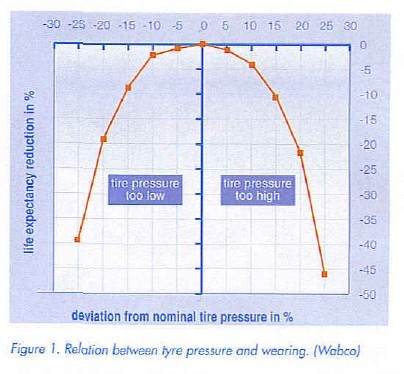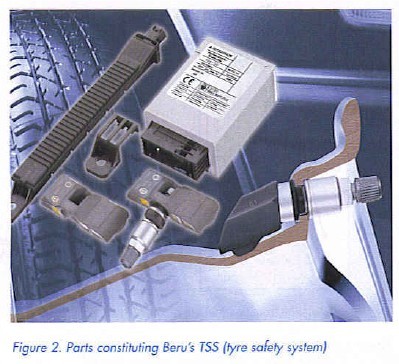

Project Solutions
Wireless Tyre Pressure Monitoring (1)
Published:2011/7/29 1:43:00 Author:Amy From:SeekIC
By Helmuth Lemme
Sudden tyre failure is not only annoying but also downright dangerous. In the future, new technology will help to reduce the number of accidents caused by tyre problems, with recently developed sensor systems constantly guarding tyre pressure and issuing a warning signal well before disaster strikes.
In 85% of all cases, tyre rupture or explosion is caused by too low pressure. The real cause, however, is increased friction leading to excessive tyre temperatures and material failure with often catastrophic consequences. Slightly less worrying, even a small loss of tyre pressure causes not only increased wear but also higher fuel consumption due to increased rolling resistance. Just as with too high pressure, the life expectancy of the tyre is significantly reduced (Figure 1). Since there are no tyres with zero rolling resistance, and pressure checks by the vehicle driver are insufficient, an electronic alternative appears useful and more than welcome. The first systems are now in volume production. Each wheel contains a module measuring the tyre pressure and temperature at regular intervals and copying the resulting data to the vehicle computer. The computer responds to too low or too high values by lighting a warning indicator on the dashboard. In the USA, the National Traffic Safety Admin istration has made the use of a TMPS (tyre pressure monitoring system) compulsory for new cars as of November 2003. It is expected that Europe and Japan will follow suit in the not too distant future. 
From a point of view of technology used, individual manufacturers seem to follow their own ideas. The oldest principle works indirectly: a microcomputer compares the rotational speed of all wheels, using data supplied by ABS (anti-blocking system) sensors. This principle is used by, among others, Continental for their DDS (deflation detection system). If the tyre pressure on one wheel drops, the effective wheel radius becomes smaller causing a higher rotational speed. Although such systems are cost-effective, they suffer from a high detection threshold (approx 30:« pressure loss). Also, gradual pressure loss on all tyres goes by unnoticed.
Systems with real sensors inside the tyres are far more secure. The technical challenge boils down to the ability to convey measured values from the rotating wheel to the vehicle chassis. Slip rings are too unreliable because they soil easily. Today, the standard principle is a radio link. The measurement module on the wheel not only contains a microcontroller that turns the values supplied by the pressure and temperature sensor into a digital data packet, but also a small RF transmitter operating in one of the ISM bands (usually 433 MHz, rarely on 2.4 GHz). The unit is powered by a Lithium battery which should last for a couple of years but is nonetheless a serviceable part. The module should be up to harsh conditions: strong vibrations with dynamic peak acceleration exceeding 2000 g, dirt, water, salt, ice and snow, yet have the smallest possible dimensions and weight. A receiver antenna is fitted in each wheelcase, or a single antenna centrally located under the chassis. A second microcontroller computes the measured values.
The above systems are available from Beru (TSS, Tyre safety system. Figure 2), Wabco/Michelin (IVTM, integrated vehicle tyre pressure monitoring). Continental (TMPS, tyre pressure monitoring system) and a few other manufacturers, in principle they are similar, but different when examined in detail. For example, the Beru wheel module that forms a compact unit with the tyre valve is fitted inside the tyre on the wheel rim — meaning it can only be built into a vehicle by the factory. The Wabco/Michelin module is fitted outside the wheel rim, secured to the valve with small pneumatic tubes so it can be “retro-fitted” without so much as having to remove the tyre. Other systems for trucks and utility vehicles differ widely because of the large variations in tyre pressure.

Reprinted Url Of This Article: http://www.seekic.com/blog/project_solutions/2011/07/29/Wireless_Tyre_Pressure_Monitoring_(1).html
Print this Page | Comments | Reading(850)
Article Categories
New published articles
· Imagination works with TSMC to develop FinFET process
Author:Ecco Reading(45531)
· XMOS pushes event-driven MCUs with lower price
Author:Ecco Reading(4142)
· Intel brings upgraded 32-nm SoC for smartphones
Author:Ecco Reading(3865)
· Micron pushes TLC 128-Gbit NAND flash
Author:Ecco Reading(4611)
· Intel will stop supplying desktop motherboards
Author:Ecco Reading(5961)
· Processor market was expected to regain strength in 2013
Author:Ecco Reading(3957)
· It was reported that TSMC sales fall steeply
Author:Ecco Reading(3619)
· Cisco, NXP work with auto wireless startup
Author:Ecco Reading(4283)
· Micron was impacted by manufacturing glitch
Author:Ecco Reading(4647)
· China can make 22-nm transistor by themselves
Author:Ecco Reading(4485)
· Chip market rebound is coming, according to survey
Author:Ecco Reading(4386)
· Sony, Toshiba will spend more on chips, iSuppli reports
Author:Ecco Reading(3954)
· Qualcomm becomes the 13th company to join NFC Forum board
Author:Ecco Reading(6795)
· TSMC increases building work for FinFET fab
Author:Ecco Reading(4467)
· TI plans to cut 1,700 jobs in OMAP shift
Author:Ecco Reading(5327)